The dream from the beginning to the present day.
Perhaps the dream was for him, at the beginning, only a natural phenomenon and he had to access to consciousness and therefore to question his existence, the world, the meaning of life, to question himself on this activity which, every night, escapes his control: the "thought" of the dream.
The memory that man has preserved of his past, thanks to writing, makes it possible, by going through the history of humanity, to explore the main stages of his intuitive understanding of the dream, to lead, in the century that is ending, to a much more organized search for the physiological and psychological supports that give him life.
After having been, at the beginning, a gift of life, the dream has thus become, from now on, a subject of study to understand better the very mechanisms of life. But, as in any research, the answers raise more new questions than they provide solutions. At the dawn of this new millennium, the same questions remain :
What is the dream ?
What is it used for ?
In an attempt to answer this question, we will try to understand
how man and his thought seem to have evolved.
1 - The domain of the gods.
| - Animism or the geniuses of nature : |
Life speaks directly to human consciousness and it is the spirits of nature that intervene in dreams: the spirit of the mountain, the forces of nature, the animal spirits and, sometimes, the totem animal of the shaman or tribe.
At that time, in a way, the dreamer's brain is indirect communication with nature and life.
Gods and nature are one. |
 |
| - Polytheism : |
Man no longer hears the voice of the geniuses of nature, but he receives the messages of the gods in his night dreams. However, too far from them to understand their meaning, he must call upon a mediator capable of transcribing the language of the dream into the language of words.
Thus, when Pharaoh dreams of seven lean cows eating seven fat cows, it is Joseph who is called and announces that a seven-year famine (the seven lean cows) will fall on Egypt.
Among the Greeks, in the temple of Delphi, it is a young virgin, Pythia, who fulfils this function of medium, receiving in her dreams the the message of the gods which will be decoded by the priests.
The gods dissociate themselves from man and leave for another space : Olympus. However, they remain in contact with nature, while having acquired human characteristics. |
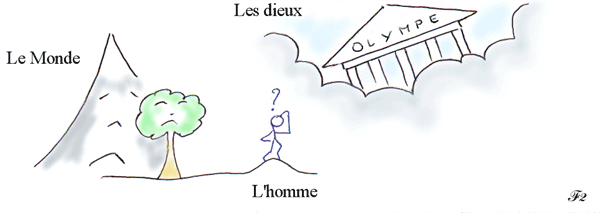 |
| - Monotheism : |
Two principles govern life : Ka : the vital energy and Bâ : the soul.
However, it is Judaism which finally reunite all the potentials existing in nature into a single God; this single God is definitively dissociated from man and the world.
The gods reunite in one God, who is totally dissociated from the world. |
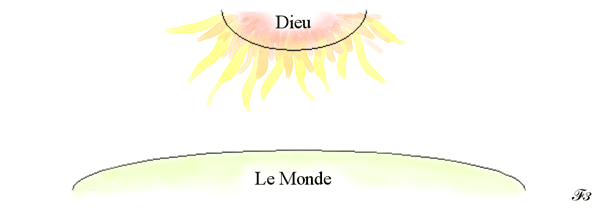 |
God reveals Himself only to His chosen ones in dreams: thus, in the Old Testament, it is with Jacob or Abraham that Yahweh communicates.
Then this God becomes the terrible and vengeful God, the one who forbids and judges.
Man, with his judgments, created God in his image. He transposed his personal conflicts into the two worlds of energy and matter.
God becomes the good. And evil appears: everything else, life, nature, man and the world, become the material exterior to get rid of in order to reach God ...
As for the geniuses of the sensitive nature, the "deimon", they become demons ... The devil!...
Spirit is divinized, and matter is downgraded. |
 |
Then there remains a "pagan" world, hidden, suffocated by the official faith.... It is the world of elves and fairies, the sensitive soul of the dissociated nature of man and his personal and profound nature ...
Man has become a pure reason subjected to the higher spirit, but he is sometimes invaded by beings of the shadows: fairies, elves, geniuses and giants who personify his sensitivity, now hidden in the folds of the mother earth.
But at the very moment when human thought dominates and discards everything that does not satisfy () his criteria, a new current of thought emerges : "God would have become man !..".
In other words, man discovers in himself a new potential: he possesses in himself the equivalent of God and life.
So ? ...
Could man become God again ? ...
God become human again ? ...
The inaccessible become accessible again ? ...
Two worlds coexist, independant of each other: the world described, and the world felt. Will they be able to reassemble ? |
 |
2 - The field of psychology.
| The turning point of this research was initiated by Freud who laid down a new principle: within man, as opposed to his consciousness, there is another domain, the unconsciousness. | 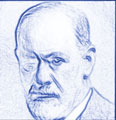 |
But the dream belongs to the domain of this unconsciousness ...
In his attempt to elucidate the functioning of the dream, he sets out several principles :
- the dream is the realization of an unconscious, repressed desire. Man therefore possesses two behaviors, one that remains conscious, made of wishes that he carries out, the other made of wishes that he cannot carry out and that he represses.
- this other part also contains our most painful memories which, as they emerge, could bring back suffering. These memories, made of trauma or deep needs, cannot be expressed in our rule-based social world. We know that a traumatic event can create amnesia: this forgetting mechanism is indeed the natural way for the consciousness to avoid suffering or fear. In the same way, we can remove from our lives any pleasant element that cannot be realized: any drug addict knows that he must avoid being in contact with the object of his desire in order to resist relapse; any rejected lover knows that he must avoid meeting the loved one to escape suffering ...
The spontaneity of our childhood must therefore also be forgotten, or even rejected, when we have to be contented with the rules of social life.
In everyday life "something" therefore blocks our consciousness, and even in dreams, the dream message would be coded not to be recognized, because this recognition can lead to suffering.
Finally, sexual taboos play a major role: a woman with a strong desire for male castration can dream that she eats a carrot.
The greater the censorship or suffering, the more complete and complex the disguise will be.
According to Freud, several processes are at work in the encryption work that the dream performs inside ourselves :
- displacement : replacing one conflict situation with another, less emotionally charged : the evil mother becomes a witch! It is easier to accuse a witch of all evils than one’s own mother ...
- condensation : the same image can condense several others. Let us take the example of a candlestick decorated with an angel: the candlestick can represent the father, his light that illuminates our lives or his rigidity; the angel will evoke the fact that he is dead.
- their representation by the opposite : we want a woman, and we dream that she is the one who loves us and that we do not love her.
- the imaging of feelings : we are angry, and this anger is imaged by a storm with thunder rumbling.
To interpret, it is therefore necessary to free oneself from the apparent meaning of the dream and to reveal another hidden logic.
And for that there are different ways :
- to go back to the recent past.
- to use free associations.
But already a question arises: how could functioning be so complex when nature has accustomed us to the simplicity of its systems? Would the dream escape this law ?
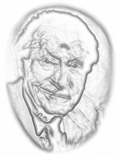 |
Jung takes up the bases of the analysis of dreams by Freud : certainly the repressed unconscious wishes and the past are well present in the dream, but he admits that it can talk to us about the present and consider a possible future. |
He develops the idea of the "personal unconscious" (specific to the dreamer's lived experience) to extend it to the collective unconscious (specific to the experience lived in the society in which the dreamer lives, and linked to the very past of humanity) common to all men, and staged by tales (the witch, the dragon, the giant and the dwarf...), myths (Oedipus and the sphinx) or religions (the gods and the demons)...
For Jung, universal wisdom, is locked into the human unconscious and can reappear through dreams ...
This experience, no longer limited in time to personal consciousness, but having the experience of Life itself since the dawn of time, would then be at the origin of the creative imagination.
If the collective unconscious reflects a permanent past of all human dreams (the sun, the sea, the dragon are universal symbols) and must be approached by the analyst and the latter's knowledge of mythology to help the understanding of the dreamer, the personal unconscious can only be approached with the intervention of the dreamer himself. He alone is capable of defining what he means by sea :
His mother ?
A pleasant place to swim ?
A scary place where he can drown ?
A place where he "has fun" windsurfing ?
A disturbing place where he can be touched by things that move, algae that cling to his ankle, and moray eels that can bite him ? ...
Finally, for Jung, while it is necessary to grasp the hidden meaning of the dream, it is important not to neglect to focus on the visible meaning. So, for this woman who dreamed of a carrot: of course the image of the carrot can be a code to say sex, but it is also a carrot, and it talks about root, food reserves for the plant, energy reserves for the one who will know how to feed himself, and the decision to feed his own life if the person puts it in his mouth ...
Finally, if the unconscious is able to assemble, despite the censorship of consciousness, all the hidden information, we can hypothesize that it can "know" before we are aware of this knowledge, and () warn us through the dream ...
Jung has therefore developed this informative quality of the dream, which can be found in the study of dreams of the past such as the dream of Pharaoh and the seven plagues, or in the study of dreams of the present such as the dreams of Niels Bohr, Kekule and many others (see "4 - The field of intuition and evolution").
Thus the dream could be both a witness to the past and a harbinger of the future.
Already, in the Hebrew tradition, the Jewish philosopher Maimonides considered that the dream announced the future and had as its mission to awaken man by making him feel a truth that he carried within him without his knowledge.
In the past, man was explained by an all-powerful external divine creation. Then two thousand years ago a first attempt was made to reintegrate God into himself. Man discovered a new possibility he would be the son of God, or God would have made himself man, that was another original attempt trying to explain man from within.
The Christian era begins : the spirit reintegrates into the world and into man. |
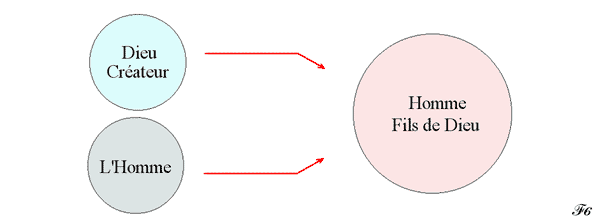 |
| Thus, nowadays, the ultimate outcome of creation or evolution is always man, but after having been God's creation and then becoming the outcome of God's own transformation, it is now made up of two parts : - part of which he is aware, - and another part of which he remains unconscious. And if we schematize this unconscious, it can be both a dump memory and a creative memory. |
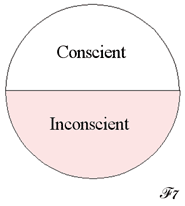 |

To achieve reunification, it then becomes necessary to understand this "other" within ourselves, and to be tolerant to this part so different that we have preferred to isolate within ourselves. Isn't our own unconscious' made of everything we reject ?
3 - The field of science.
This study () made it possible to define and specify the neurophysiological characteristics of dreams, without however reaching their decoding ...
Some functionings are becoming clearer, and other hypotheses about the usefulness of the dream can be put forward, but the code is still obscure.
First of all, sleep, which was considered as a homogeneous phase during a 24-hour cycle, is constituted by an alternation of different phases, the two main ones being slow sleep and REM sleep, the electroencephalographic plots of each of these two phases being totally different.
Thus physiologists can observe certain characteristics of the dream state: the phase of cerebral activity linked to dreams is accompanied by total muscular atony, but at the same time the eyes are agitated with rapid movements from left to right: the sleepers awakened in this phase can relate the dream they were having ... This phase is called R.E.M. ("rapid eyes movements") and the consistency of these phenomena shows that babies and animals have also this type of brain activity related to eye movements, even if they cannot tell their dream.
Each night consists in a series of cycles of about an hour and a half during which we dream twenty minutes, for a total of about an hour and a half of dreams per night.
Electroencephalographic studies have thus made it possible to probe the intimate functioning of the brain, and to determine that during the dream and the state of awakening the same cerebral zones are activated: for example if one plays tennis, it is the sensory-motor area of the corresponding member that is activated, which is confirmed by the experiments carried on by Professor Michel Jouvet on the cat: when the area that inhibits body movements is deactivated, the dreaming cat gets up, explores its environment, and then behaves exactly as it would if it were awake, for example in a hunting activity.
This would explain why the world of dreams often seems as real to us as the world of everyday life. In this regard, we have been able to quote the example of the subject who dreams that he is guillotined, and wakes up with a start: the frame suspended at the head of his bed has fallen on his neck.
However, at the same time, studies have shown that there is not a single case where an external stimulation becomes the central subject of the action taking place in the dream : most often this stimulus does not even appear because the body is disconnected from the outside world.
So how do you explain the dream of the guillotine?.... This dream is too old to be explained, because the conclusions drawn from it were drawn only from the dream, and without taking into account the moment when it appeared... Slow or REM sleep? Indeed, dreams can also occur during slow sleep, these dreams are then called "hypnagogic" and during slow sleep there is no inhibition of sensory receptors.
Neurobiologists have also established that the dream originates in the ancient layers of the brain stem, in the pontic neurons (fig 61), and that it is realized in the right hemisphere of the brain, home of the imagination and affects.
During the sleep, the connections that connect it to the left hemisphere, the "logical" brain, are inhibited; and contact with the archaic brain (reptilian brain) is facilitated (fig 9).
A question then arises: why don't snakes, fish, and other cold-blooded animals dream? dream? And why does REM sleep appear in the animal world in birds and mammals ?
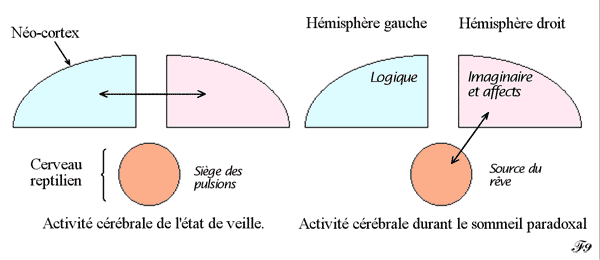
To dream, you must therefore have acquired what is called the neo-cortex (new cortex) and warm blood ! The opossum, a North American marsupial marsupial that has been dreaming and existing for 180 million years, makes it possible to estimate the implementation of REM sleep at that time. But how do you we know if your ancestors were dreaming ?
Finally All things cosidered, it would seem that the dream depends on evolution and therefore on genetics: studies, carried out on separated identical twins separated from birth, show similarities in their dreams, and the different living conditions after birth cannot be taken into account here to justify this similarity.
But if the study of the biological mechanism of dreams progresses, their raison d'être purpose remains subject to hypotheses.
Brain specialists explain that the dream is used to process the information accumulated during the day, to store it in our memory and to sort it.
For Professor Jouvet, the dream would serve to permanently reimpregnate us with our psychological and instinctive heredity: without this permanent reorganization within the dream, our real personality could be totally erased by the influences suffered within the society. In other words, we have a genetic personality: during the day, social influences modify this personality, and at night we would reorganize the events of the day by reprogramming these events so that they remain consistent with our deep personality, without obscuring it. Thus, during REM sleep, before even expressing facial expressions that will only come true a few weeks later, the newborn child smiles, makes facial expressions of joy and fear, as if learning genetically acquired data.
However, While there are many hypotheses, one certainty has been established about the usefulness of REM sleep in memory : it has been shown that REM sleep accelerates the fixation of memories and that, in the laboratoryies, mice that learn faster are those with a longer dream phase. Conversely On the other hand, animals that do not have REM sleep essentially have above all instinctive reactions and learn with great difficulty. They cannot be trained or conditioned.
This would suggest that it is necessary to reach a certain stage of evolution for the nervous system to question the data of purely genetic evolution: it will then be able to compare the different data of a problem, choose between old or genetic behaviours and new or learning behaviours, in order to react to the new situation.
This learning data is confirmed by the dreams that have allowed human knowledge to progress or that have given another direction to the dreamer's life.
But, on the whole, the discoveries of science raise more questions than they provide answers.
Indeed, if the dream coincides during the night with the lowering of body temperature, how can we explain that cold-blooded animals do not dream ?
The dream appeared during the evolution in homeothermic higher vertebrates (birds and mammals) but then why could we never, in the dolphin, a mammal whose brain is close to that of man, detect REM sleep ?
And why don't cold-blooded animals dream? And if the dream is not necessary for them, why should it be necessary for homeothermic vertebrates ?
How is it that evolution has preserved this nocturnal state, so dangerous in the natural world, which isolates the dreaming animal from its external perceptions and motor reactions ? In this state, he is delivered left to his own devices , to his possible predators, protected however by a correction of nature: hunted animals have little REM sleep, 15 to 20 minutes per 24 hours, against 3 hours REM sleep and more per 24 hours in their predators.
The fact that only dreaming homeotherms have been selected is a mystery! Could REM sleep be due to the fact that in cold-blooded animals, brain neurons divide all their lives, while in warm-blooded animals, very quickly, they stop dividing very quickly ? Mice subjected to the labyrinth test memorize the path better if the REM sleep phase following learning is allowed to take place, with the length of REM sleep duration always being increased (by 30 to 60 percent) after a learning period.
On the other hand, the temporary REM sleep deprivation in mice leads to an increase in the duration of REM sleep after this deprivation, which would confirm its importance.
But how can we explain that humans who do not dream, following an accident or under the effect of certain drug treatments, do not have any memory problems ?
How is it that depressed people get better if you suppress REM sleep for one or two nights ?
In the current state of knowledge based on experimentation, neurophysiologists have still not yet found an answer to this question: what are the causes and functions of dreams ?
So, on what basis should we study a phenomenon for which we know neither what creates it nor what it is used for ?
Nowadays, man considers the dreams , no longer as an external message from the gods, but as an internal message from his psyche; it is now the neurophysiological support, with incomprehensible motivations for the moment, that is explored.
4 - The field of intuition and evolution.
In each of our dreams, something is created that transcends all limits and seems to defy all logic.
Our dreams amaze us every night just as the life around us amazes us and will always amaze us as men progress in the discovery of the universe, whether it is infinitely large or infinitely small.
1 - in relation to the world that surrounds us and is our daily life, who can say how "something" in us reveals itself capable capable of understanding the world and apprehending it, to the point of giving us sudden insights answer the questions that haunt us in the faced of with these mysteries ? ...
When the Marquis de Puységur discovered hypnosis, he simply discovered a way of drowsing his conscience and awakening in his groom what Freud later called "the unconscious"; he the latter was then able to describe his illness and provide the means to cure it when he had no conscious knowledge of it.
We have seen that, since antiquity, there have been many examples of these intuitions, which occurred in dreams, and which have contributed to our understanding of the world.
- in the world of science, the dream or rather this "other form of thought" in us, has helped researchers :
It was in a dream that Niels Bohr discovered the structure of the atom allowing him to finally get an idea of this object, which had previously been "unbreakable" and considered as the smallest part of the matter, opening onto modern atomic physics as the physicists of his time were groping into a new world of which they were not yet able to form an image.
It was also in a dream that the German chemist Kekule discovered the molecular structure of benzene: before him, science had never considered that a molecule could have a circular structure.
- housewives and industrialists can also have an emotional thought for another unknown dreamer who has transformed their lives, the American Elias Howe who found the idea of the sewing machine needle while sleeping.
- in the world of literature and art, this centre of creativity has, once again, revealed its abilities :
Descartes dreamt the plan of his "Discourse of the Method".
In his sleep, Wagner heard the prelude to the "Gold of the Rhine", Mozart heard the theme of the "Magic Flute".
As if the thought of everyday life were the place where questions arise, and the unconscious the place where answers are developed.
When the individual falls asleep, rationality seems to give way to a freer, broader form of thought, capable of developing syntheses to which everyday thought does not have access. Such dreams support the effort of intelligence that daily life demands.
The intuition of the "seers" is still in the realm of the unconscious! But if this intuition can be right when it comes to guessing the other, it also shows its limits, which can be totally lacking , when it comes to knowing oneself... Perhaps precisely because the characteristic of our unconscious is to escape ourself.
It is this part in us that "dreams" that has the gift of creativity...
Inside our nights, it creates any object, any color, any situation, it gives rise to any feeling.
It is the part that creates the painter's work, the "pure creation" that the painter's reason will then reproduce with his hands on the canvas or on any medium... It is the artists who are the least structured by the social viewpoints who can give free rein to their imagination... Dali, Picasso, and many others, have been able to freely express the creations of their unconscious to become the precursors of another art form.
The superior cortex of the human being uses his intuitions to make objects of his daily life: a tool, a house, a machine, but it is the unconscious that makes it possible to create the unique and sometimes useless work like the Eiffel Tower, or the first work, object of all sarcasm, before reason discovers its utility and becomes the work of all in the years that follow...
Freud's unconscious ? A genius intuition that has transformed our century...
The radioactivity of Pierre and Marie Curie ? Our rationality has been able to extract the energy from it, but at the end of how many intuitions it has never been in control of ? ...
However, the subject that interests us today is not this intuitive form that opens up the outside world to us, but this force within us that opens up the unknown spaces of our inner world to us.
2- Within ourselves : our reason knows very well how to transform intuitions that have arisen in dreams into concrete achievements. This behaviour, useful for the individual survival and continuity of the species, suggests that this mechanism has been selected by nature... But if you don't know "how it works" in itself, isn't it more interesting to see what it could be used for in itself ?
If we look at the evolution of species from the beginning, we could assume that this same evolution does not offer any limits. Everything, life or death, animate or inanimate, can be selected with three essential components: emptiness, energy and matter.
However, this is what we will find inside the dream :
The impossible has become possible, all the facets of our creativity suddenly achievable, before the eye of subjugated reason...
- impossible to be angry for the shy or educated man ?
- impossible to cry for the strong one ?
- impossible to act for the weak ?
- impossible to build a house for the intellectual ?
- impossible to fall into the void and survive for the one subjected to vertigo ?
- impossible to breathe underwater ? to evolve in space ? to paint works of art, to use spaceships, and to go back in time to chat with a dinosaur ?
- impossible to kill ?
- impossible to love ?
Only the thought of reason in us decides the impossible... The thought specific to the dream, on the other hand, never discusses: it merely describes the universe of the possible to which the dreamer accesses.
This is what will define for us the interest of the dream.
It seems that our reason, it seems, only sees life in a way that dependsingon the rules learned or imposed within the family and social structure; on the other hand, everyone has their own conception that can lead them to conflict with or even destroy each other. But where while he different human reasons are always in disagreement, the unconscious has no opinion. He only knows perfectly what life is, to perfection, describes it, and describes its absence of limits. Absence of limits whose reason will refuse to accommodate itself or will accommodate itself by eliminating from the outset right away what does not interest it...
- a dream is normal ? It will be accepted...
- but what if it's abnormal? It will be forgotten...
- what if it's a nightmare? He It will be discarded because he it is too painful even if his its memory is imposed by his its strength... ( even it’s too powerful to be forgotten)
For the rational human consciousness, everything that does not belong to the logic of the laws enacted is excluded, isolated in an unconscious "attic"..
And yet, more than the dustbin of the useless, our unconscious seems to contain the treasure of the knights of our childhood tales, this Grail for which no sacrifice, no trial was useless. These treasures, this knowledge, revealed by ../livre1-img, music, and illogical advice that he unconsciously expresses in the dream or in everyday life, it is up to us to consciously realize them, by a carefully considered decision: "I dreamt this? It's up to me to make it happen!".
Thus dreams, the support of our fears and creativity, could well contribute to our transformation.
In parallel with the development of neuroscience, other American researchers, exploring the world of civilizations, discovered in the 1950s a tribe from Borneo, the Sénoï, whose culture has an essential and surprising facet in our eyes : the analysis of dreams.
This interpretation of dreams has been practiced at home since early childhood and shared by all the members of the tribe. Every day they meet to tell and analyse their own dreams, but this analysis never remains for them a purely abstract subject of elaboration, it is totally integrated into their daily lives.
For the Senoi, as soon as a conflict appears in a dream, this force, which could be evil, must be transformed into a beneficial force... Thus, the fear generated by an incursion into an unknown field populated by strange beings will have to be transformed into curiosity and a desire to discover this new world....
When a child dreams that he will falls, the adult will not see "a priori" in principle, as we do, the disturbing side of the event ourselves, but will reveal its wonderful side : "Where did you fall ?..." "What did you find out ?..." And he advises the child to take pleasure in falling instead of being afraid of it, to let himself fall rather than wake up, since he is obviously still alive: it was only a dream! For them, falling is the easiest way to get in touch with the powers of the spirit world; entering the spirit world is the best way to learn and, by returning to reality, to exploit the experience gained ...
Thus, oral tradition goes beyond mere education by allowing the children of this tribe to integrate the inner experiences from which they can feed and further enrich their culture. This approach not only allows them to face their inner feelings such as fear, but also to transform their feelings in the event of a relational conflict within the group: when a dreamer sees himself attacking a friend, he talks about it with him when he wakes up and offers him a gift to restore good understanding...
Thus, the dream allows this tribe to ensure all the psychological balances, individual or social; the surprising particularity of this society is that in 300 years, it has known no war, no crime, no relational conflict ! ...
From times immemorial, dreams have always been the support of the possible, but since man is too much subject to unavoidable social constraints, the gods alone could possess the absolute power that is the freedom to act.
But for us today, dreams, belonging to the realm of the unconscious, have become too foreign to us to understand and consciously take advantage of them; however, they represent a potential for freedom. Perhaps it is up to us to let him it express him itself ?
For the current today’s men who have left the domain of the gods, who do not adhere to the world of the unconscious described by Freud, and who do not yet find yet in science the expected answers, the dreams remains the domain of intuition, a domain that is not well known.
Would the dream be only in the realm of intuition? Would it not rather be in the field of learning and maturing information within a broader and more effective system than that of human reason alone ? Maturation leading to answers that our consciousness would never have suspected...
3 - The encounter of the inner universe and the outer world :
As we have seen, science has determined two types of dreams within the night :
- hypnagogic dreams, very close to everyday thinking, and describing "normal" situations.
- and dreams strongly dreamlike.
Similarly in painting, we have very "descriptive" paintings of everyday reality, like those of Rembrandt, and strongly "dreamlike" paintings like those of Dali.
The dream could be considered in different ways.
For the believer, even today, it can be received as a divine message by the believer. The scientist can accept it as a description of previously undecipherable phenomena that can then advance make knowledge progress. Pictorial representation, visual message, would it not ultimately constitute a language addressed to the dreamer (minor dream) and even to the community, depending on the importance it has for the latter (major dream).
Thus, more than the support of creativity (since a work of art is a creation), wouldn't the dream be rather the support of a language (since this creation is used to communicate) ?


